Highlighting the untold power and influence of biblical sisters, delve into stories of faith, rivalry, and transformation that will surprise and inspire you.
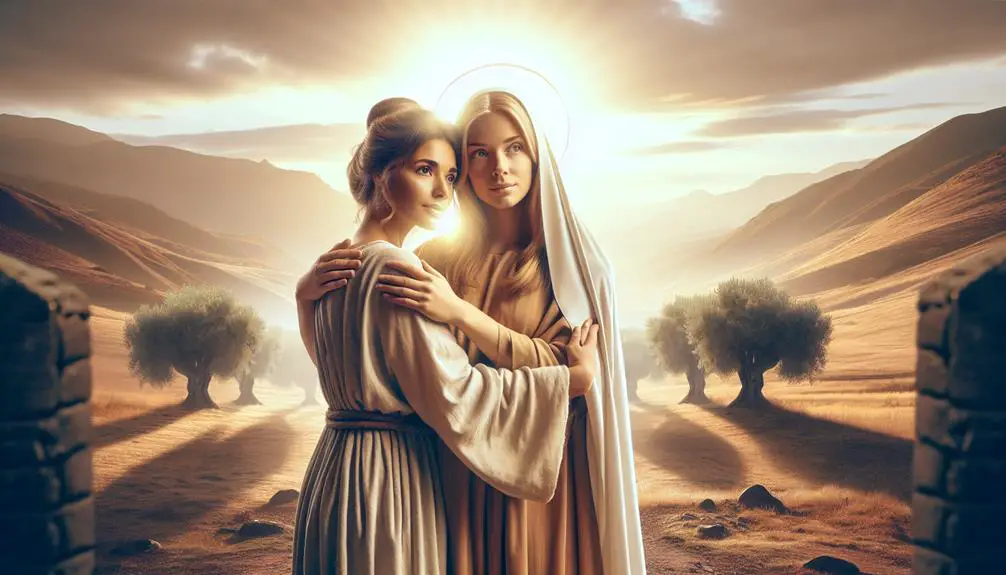
Sister in the Bible
In the vast expanse of the Bible, sisters wield power that could rival the might of kings and prophets. You've likely heard of Miriam's watchful eyes over Moses, but that's merely skimming the surface.
Consider Leah and Rachel's complex relationship, tinged with rivalry yet bound by blood, or Martha and Mary's profound devotion that teaches lessons in faith and service.
Then, there's the bold stand of the Daughters of Zelophehad, challenging societal norms, and Rebekah's decision that altered the course of history.
Each story unfolds layers of strength, wisdom, and influence, beckoning you to explore further into their lives and legacies.
Key Takeaways
- Sisterly relationships in the Bible range from protective vigilance to rivalry, reflecting the complexity of familial bonds.
- Biblical narratives highlight the impact of sisters on spiritual growth, advocacy, and divine plans.
- Sisters in the Bible serve as catalysts for change, challenging societal norms and legal precedents.
- The stories of sisters underscore the importance of balance between action and contemplation, and the influence of family dynamics on individual destinies.
Miriam's Protective Vigilance
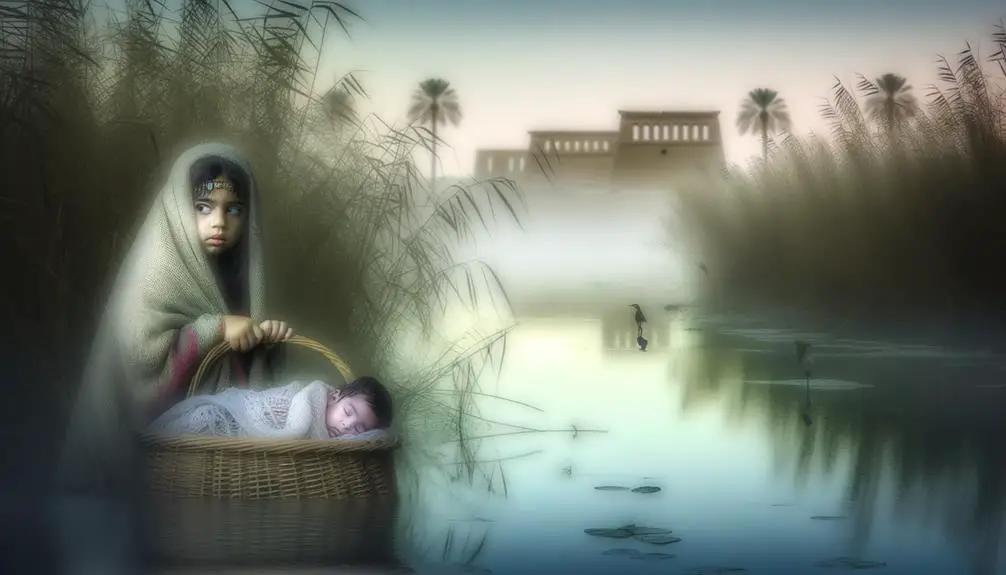
Miriam's protective vigilance over her brother Moses, as recounted in the Book of Exodus, exemplifies a profound sense of familial duty and foresight. This narrative not only highlights her pivotal role in the survival of Moses but also underscores the critical importance of sibling solidarity in the face of adversity. Miriam's actions, characterized by vigilant care, serve as a testament to the depth of her commitment to her brother's wellbeing. Her strategic positioning at a distance to observe what would become of him when he was placed in the Nile demonstrates a keen understanding of the dangers that lay ahead, coupled with a resolve to intervene when necessary.
Your analysis of this episode reveals a multilayered dimension of Miriam's character. It's not merely about her physical act of watching over Moses but also about her psychological readiness to act upon potential threats. This duality in her protective approach—both passive and active—illustrates a sophisticated form of vigilance that extends beyond mere observation. It's about being prepared to make critical decisions under pressure, showcasing an early example of leadership and decisiveness within familial contexts.
Moreover, Miriam's subsequent interaction with Pharaoh's daughter, where she suggests her mother as a nurse for Moses, further emphasizes the cunning and resourcefulness inherent in her vigilant care. This maneuver not only ensured Moses' safety but also reconnected him with his biological family, thereby preserving his Hebrew identity. In doing so, Miriam's actions underscore a broader theme of resilience and ingenuity in ensuring the continuity of family lineage under oppressive circumstances, making her an emblematic figure of sibling solidarity and protective oversight in biblical narratives.
Leah and Rachel's Rivalry
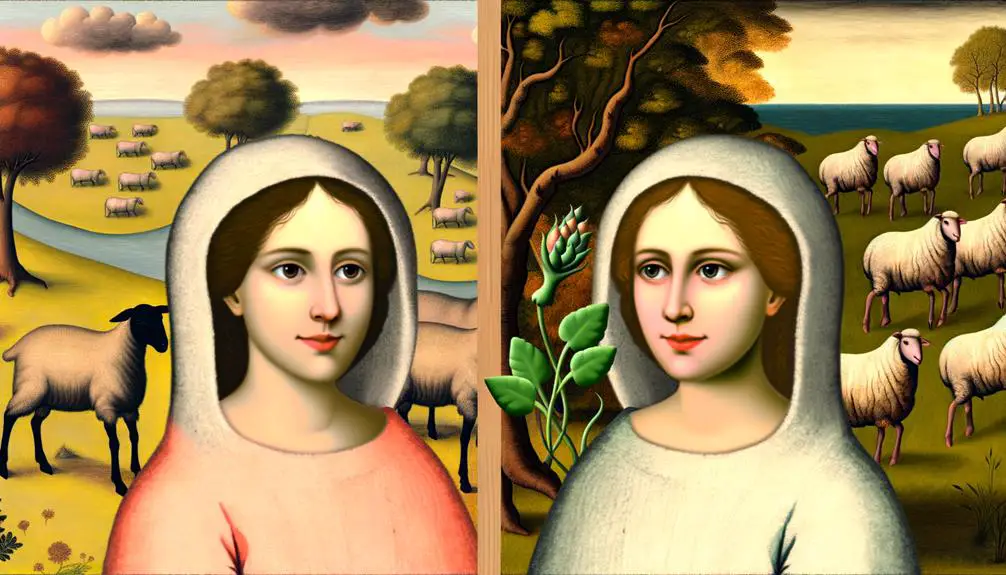
While Miriam's story reflects a solidarity among siblings in the face of external threats, Leah and Rachel's narrative unfolds a starkly different dynamic, marked by internal familial rivalry and competition. Their story, deeply embedded in the fabric of biblical family dynamics, showcases the complexities of jealous love within a shared familial space. You're witnessing a tale where love, envy, and desire intertwine, complicating the bonds of sisterhood.
Leah and Rachel's relationship, strained by their marriages to Jacob, provides a vivid illustration of how jealous love can underpin and exacerbate family dynamics. Their rivalry, fueled by a desire for their husband's affection and the societal pressure to bear children, underscores the intense emotional landscape that they navigate. This narrative not only exhibits the personal toll of their competition but also highlights the broader implications for their family's legacy.
To better understand the depth of Leah and Rachel's story, consider the following key aspects:
- The Role of Societal Expectations: The pressure to bear children, especially sons, places a heavy burden on both sisters, exacerbating their rivalry.
- Manipulation and Deception: The initial deception by their father, Laban, sets the stage for a complex relationship between Leah, Rachel, and Jacob, characterized by manipulation and shifting loyalties.
- The Evolution of Sisterhood: Despite their fraught relationship, moments of empathy and mutual understanding between Leah and Rachel hint at the potential for reconciliation and the enduring bond of sisterhood.
Through Leah and Rachel's story, you gain a nuanced understanding of the potent mix of jealous love and family dynamics, reflecting the complexities of human emotion and relationship within the biblical context.
Martha and Mary's Devotion
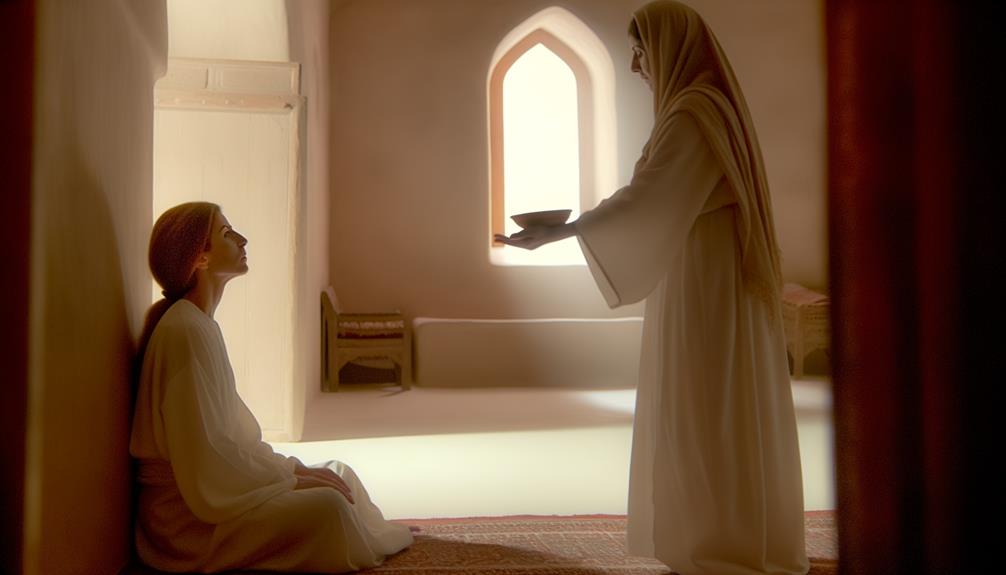
In the narrative of Martha and Mary, the Bible presents a nuanced examination of devotion and discipleship within the domestic sphere. The story, nestled in the Gospel of Luke, showcases a hospitality contrast and a spiritual focus through the actions and attitudes of these two sisters. Martha, absorbed in the labor of hosting Jesus, symbolizes the traditional role of service, while Mary, sitting at Jesus' feet, embodies a yearning for spiritual learning and connection.
Aspect |
Martha |
Mary |
|---|---|---|
Focus |
Hospitality |
Spiritual |
Activity |
Serving |
Listening |
Criticism |
Distractedness |
Devotion |
This comparison underscores the multifaceted nature of devotion. Martha's frustration with Mary, who she perceives as neglecting her duties, and Jesus' response to Martha, highlight a pivotal lesson: the importance of prioritizing a spiritual focus over the busyness of societal expectations.
Analyzing their story, you discern a broader theme: the balance between action (diakonia) and contemplation (logos). Martha's dedication to service is commendable, but Mary's choice is presented as "better" because it represents an intentional spiritual focus. This does not diminish the value of hospitality but emphasizes the superiority of spiritual nourishment and the direct engagement with Jesus' teachings.
In this narrative, the Bible subtly critiques the excessive preoccupation with societal roles and tasks, advocating instead for a prioritization of spiritual growth and connection. Martha and Mary's story serves as a timeless reminder of the importance of balancing our duties with our spiritual development, urging you to seek moments of quiet reflection amidst the demands of daily life.
The Daughters of Zelophehad
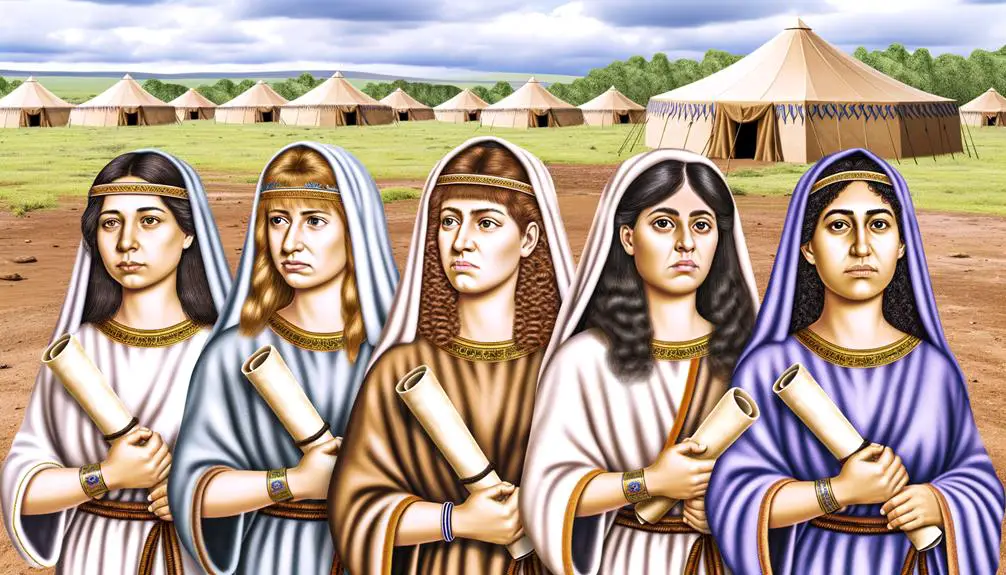
Turning our focus to the Daughters of Zelophehad, we encounter a biblical narrative that underscores the intersection of gender, inheritance laws, and societal change within the ancient Israelite context. This story isn't just a historic account; it's a pivotal moment in biblical law where women actively challenge and subsequently change the status quo regarding inheritance rights.
Here are three critical elements of their story:
- Legal Advocacy: The daughters of Zelophehad—Mahlah, Noah, Hoglah, Milcah, and Tirzah—stand before Moses, the assembly, and the priests to make their case. Their father died without a son, and under prevailing laws, his lineage would be left without inheritance. This act of legal advocacy is groundbreaking, not only for its direct challenge to existing norms but also for its successful outcome.
- Inheritance Rights: Their plea leads to God instructing Moses to transfer the inheritance rights to them, a direct overturning of the prevailing patrilineal inheritance norms. This decision didn't just affect them but set a precedent for future cases, showing a remarkable shift in the legal landscape of ancient Israel.
- Societal Change: The resolution of this case reflects a broader theme of societal change and adaptation. It highlights how legal systems can evolve, driven by challenges from those it governs. The daughters' successful appeal for their rights marks a significant moment in the journey toward gender equity within their society.
The Daughters of Zelophehad story is a testament to the power of voice, legal advocacy, and the pursuit of justice, marking an early instance of challenging gender norms and advocating for inheritance rights within a biblical framework.
Rebekah's Pivotal Choice
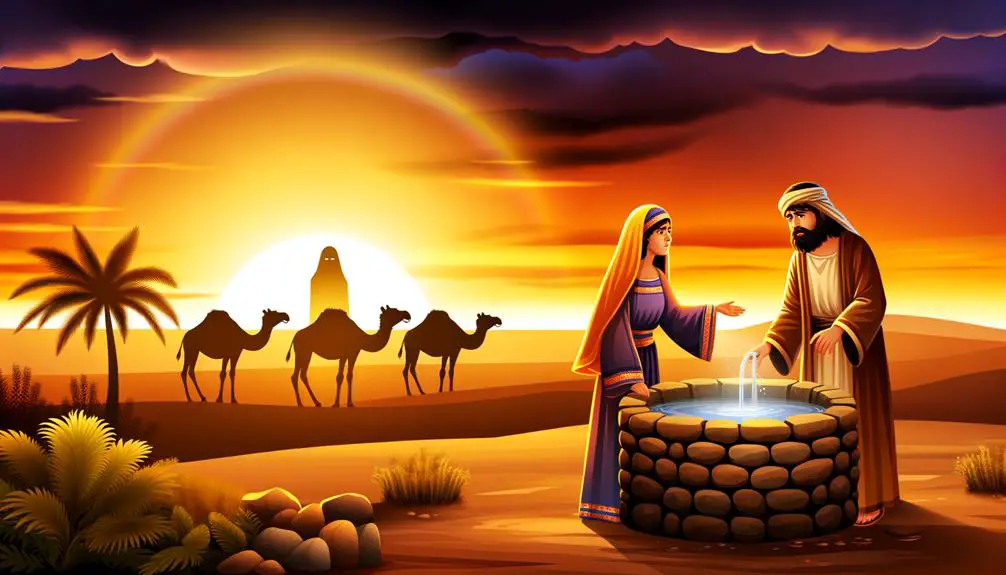
Navigating through the complex narratives of the Bible, Rebekah's pivotal choice dramatically alters the course of biblical history by favoring one son over another, setting a profound precedent for understanding familial dynamics and divine intervention. This decision isn't merely a maternal preference but a significant moment that showcases how individual choices can shape destinies within the framework of divine plans.
Rebekah's favoritism towards Jacob, over Esau, underscores the intricate interplay of family dynamics in the unfolding of God's promises. You'll see that her actions, while controversial, are instrumental in the realization of the covenant made with Abraham, indicating that divine intervention can work through human decisions, however flawed they may seem. This narrative invites you to ponder the complexity of parental influence and the unforeseeable impact of favoritism on sibling relationships and family unity.
Moreover, Rebekah's choice highlights the theme of the younger son's preferment, a recurring motif in the Bible, challenging the traditional norms of inheritance and leadership. It prompts a deeper reflection on how divine purposes often transcend human conventions and societal expectations.
In dissecting Rebekah's pivotal choice, you're encouraged to consider the dual role of divine intervention and human agency in the biblical narrative. It's a compelling example of how faith, individual actions, and family dynamics intertwine to fulfill divine purposes, offering insightful lessons on morality, leadership, and the consequences of personal choices.
This analysis not only enriches your understanding of biblical stories but also sheds light on the enduring relevance of these ancient texts in exploring the complexities of human behavior and divine guidance.
Frequently Asked Questions
How Does the Concept of Sisterhood in the Bible Reflect on the Roles of Women in Ancient Societies?
When you explore ancient societies, it's clear that women's roles were complex and multifaceted. Sister rivalry often mirrors societal competition and inheritance disputes, reflecting broader social dynamics.
Spiritual symbolism, tied to women, underscores their influence and the mystical roles they played. These narratives aren't just historical; they offer insights into how women navigated and shaped their worlds, demonstrating resilience and strategic agency amidst patriarchal constraints.
In What Ways Do the Stories of Sisters in the Bible Provide Insight Into Familial Dynamics and Inheritance Laws of Their Times?
Exploring stories of siblings offers a unique lens into the genealogical significance and legal disputes defining family ties and inheritance practices.
You'll find that these narratives illuminate how familial dynamics and inheritance laws shaped relationships and societal standings.
They underscore the complexities of lineage and the critical role of legal frameworks in determining one's place within the family and society, highlighting the intricate interplay between personal relationships and societal norms.
Are There Any Notable Examples of Sisterly Relationships in the Bible That Challenge Traditional Gender Norms or Expectations?
You're exploring how sibling rivalry and protective instincts among sisters challenge traditional gender norms. Notably, Mary and Martha's story diverges from expected roles, with Mary choosing learning over domestic duties, showcasing a shift in women's roles.
This portrayal not only highlights the complex dynamics of sisterhood but also underscores a broader critique of societal expectations, pushing against the confines of traditional female roles through their actions and choices.
How Do the Narratives of Sisters in the Bible Contribute to Our Understanding of Female Agency and Autonomy in Biblical Times?
You might think narratives from ancient texts don't offer much on female agency, but you'd be surprised. Sister sacrifices and spiritual mentorship in these stories shed light on the nuanced roles women played in biblical times.
They weren't just passive figures; they made decisions, influenced outcomes, and guided others, highlighting their autonomy and agency.
These tales challenge our preconceptions, proving that even in historical contexts, women's actions and choices were pivotal.
Can the Relationships Between Sisters in the Bible Be Seen as Metaphors for Broader Societal or Theological Themes, and if So, How?
You're delving into whether relationships in ancient texts serve as metaphors for broader themes. Absolutely, they can. Within these metaphorical landscapes, sisterly connections often embody divine allegories, reflecting societal or theological concepts.
Analyzing these relationships, you uncover layers of meaning, suggesting that these narratives aren't just personal stories but also convey deeper, universal truths. This approach reveals how familial dynamics in literature mirror and critique wider cultural and spiritual beliefs.
Conclusion
In the tapestry of biblical narratives, sisters play roles that are far from ancillary. Like Miriam's watchful eyes or Leah and Rachel's entwined destinies, their stories are woven into the foundational fabric of faith.
Martha and Mary showcase devotion's dual nature, while the Daughters of Zelophehad champion justice. Rebekah's choice, pivotal and profound, echoes the complexity of familial bonds.
These narratives aren't mere footnotes; they're essential threads, highlighting the intricate interplay of faith, loyalty, and destiny.


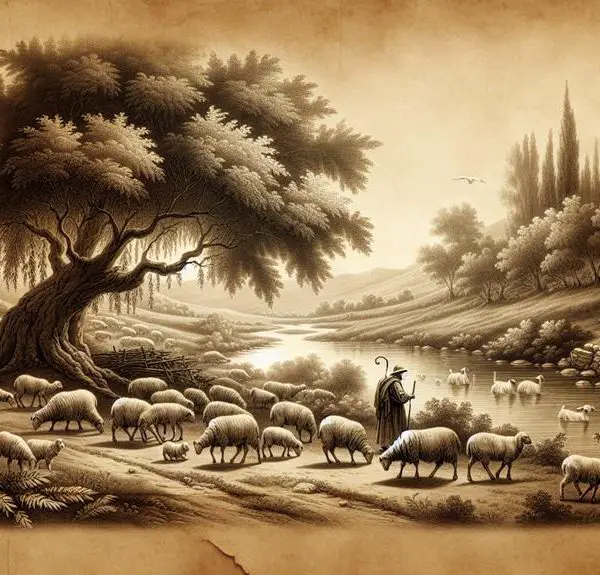
Sign up